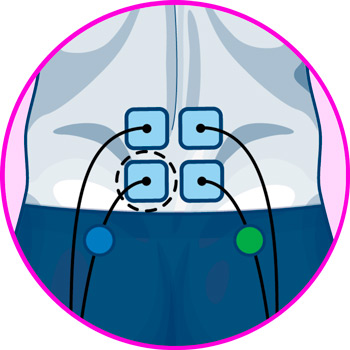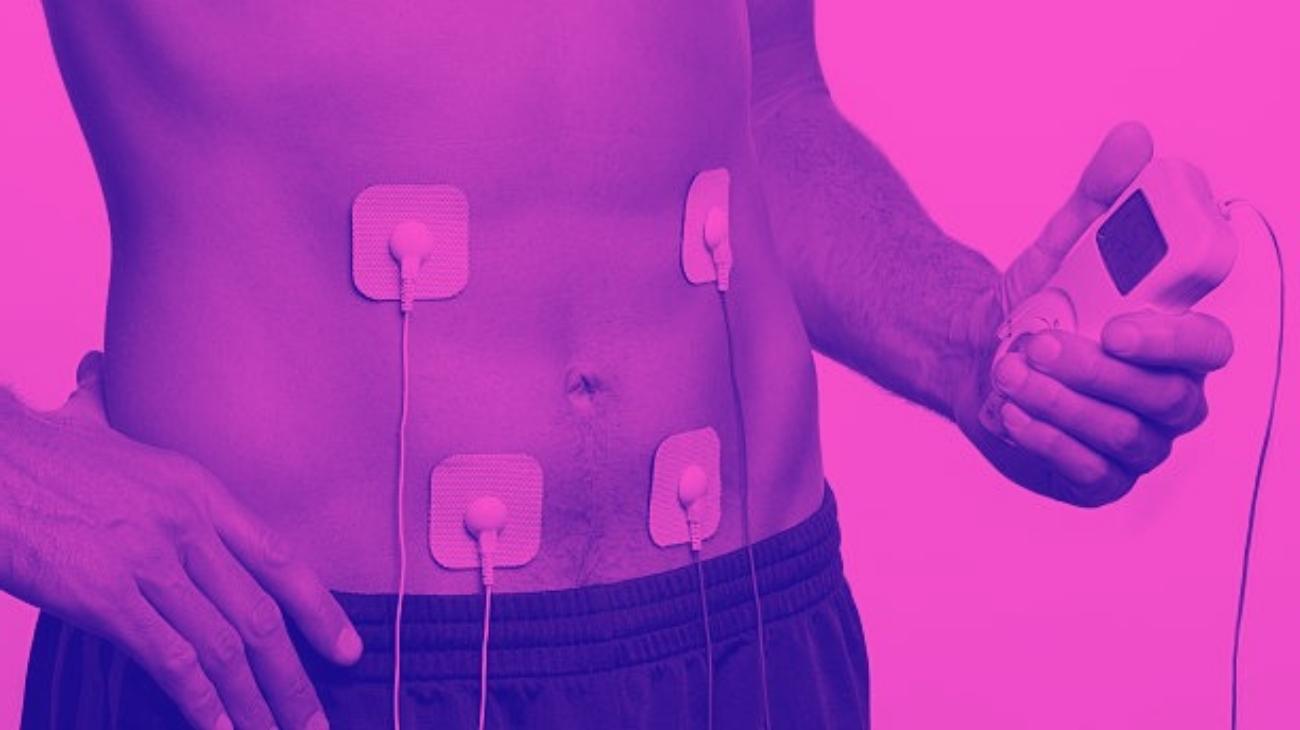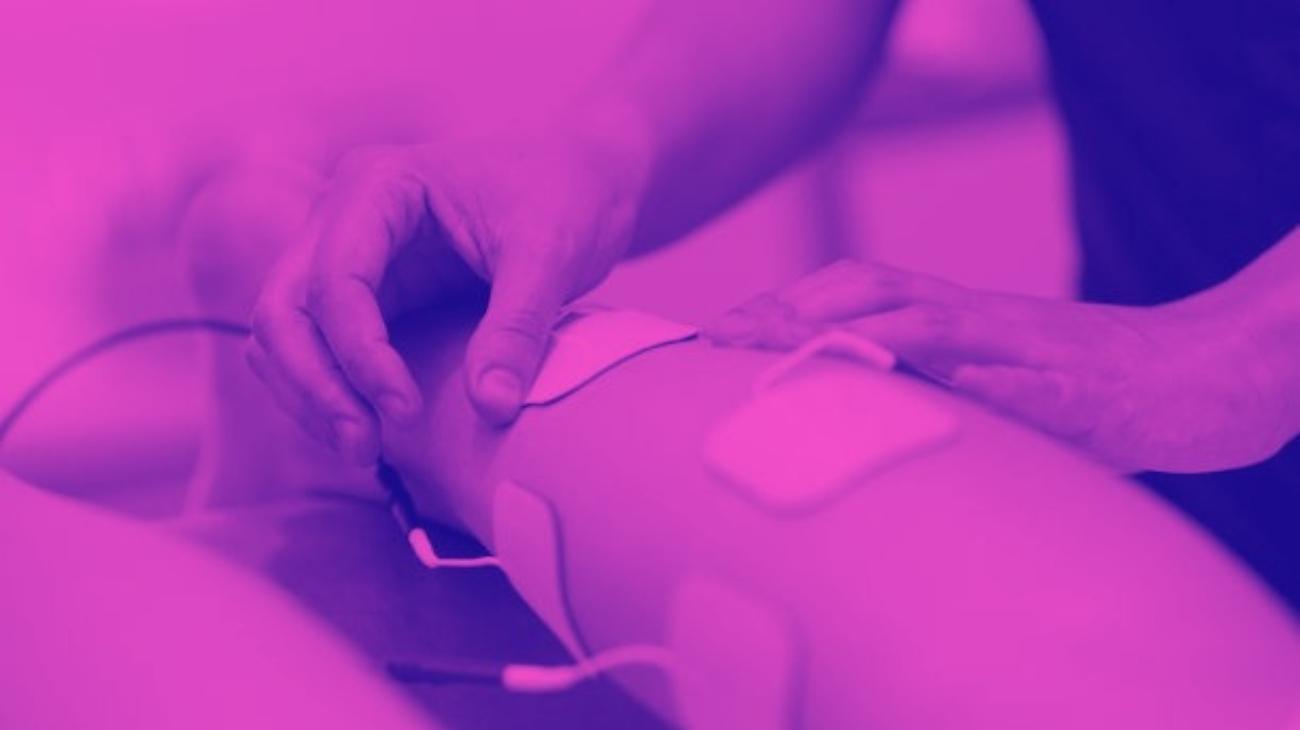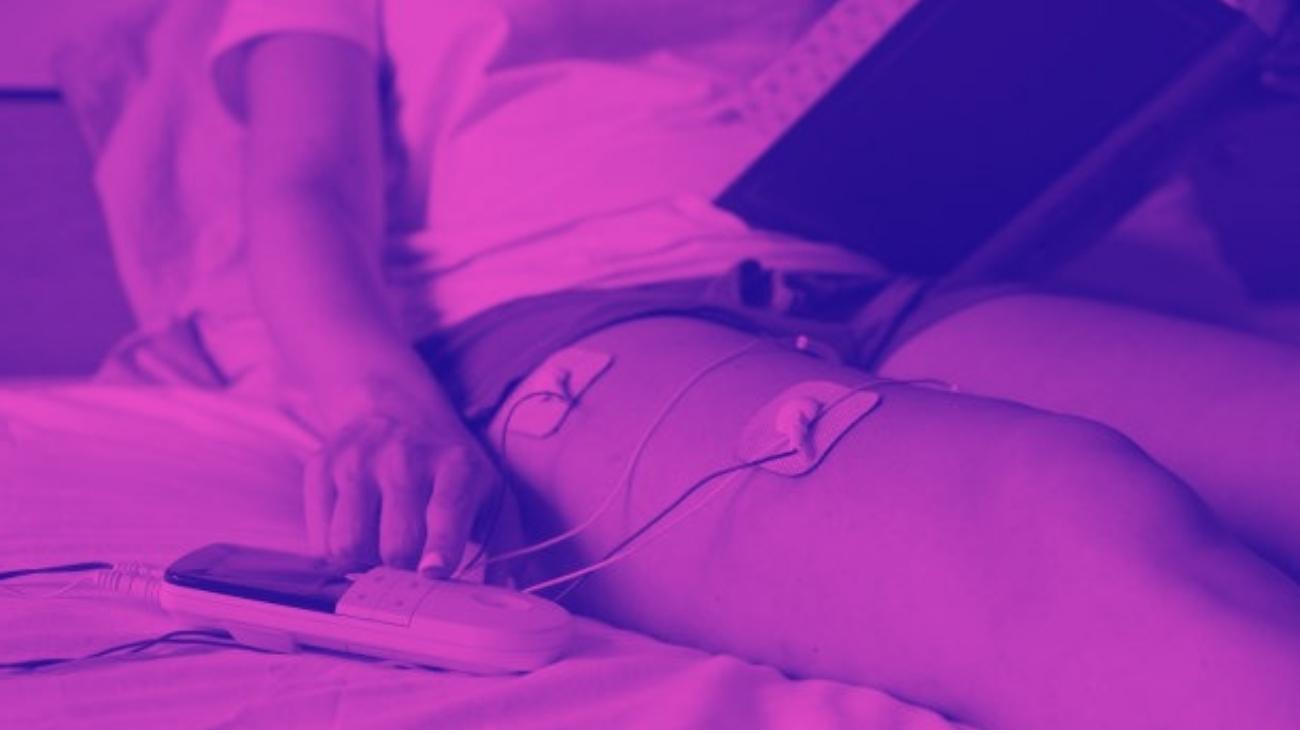- How to use a TENS machine to relieve hip pain?
- Best TENS machines for hip injury recovery
- How to use EMS muscle electrostimulator for the hip joint?
- Best EMS electrostimulators for strengthening hip muscles
- Video: How to place electrodes pads on the hip?
- More types of EMS stimulators and TENS machines you should know about
- Most common types of hip injuries
- Differences between TENS and EMS: Which to use for hip pain?
- Contraindications in the use of electrodes and electrotherapy
The hip is one of the most used joints in the human body. Also known as the coxofemoral joint, it belongs to the trunk and together with the musculature that surrounds it, it is responsible for giving balance and mobility to the body in both static and dynamic positions.
Despite being designed to be flexible and resistant, the risk of suffering hip injuries is quite high and varies depending on circumstances such as age and physical activity. Fortunately, TENS and EMS electrical stimulation therapies are designed to treat with symptoms the ailments that may affect the joint, so in the following paragraphs, we will teach you how to apply these therapies correctly to treat hip pain.
How to use a TENS machine to relieve hip pain?
The primary objective of TENS units is the treatment of acute or chronic pain caused by injuries or disorders of various origins, and their benefits can be used by both athletes and people with regular physical abilities.
Among these benefits, we can highlight the following:
- Increases pain resistance: the electric shocks produced by TENS devices numb the pain receptors located in the femoral nerve, sacral plexus and obturator nerve, mitigating the sensation of pain and generating immediate relief in the patient.
- Improved blood circulation: the heat applied by the electric shocks causes vasodilation, which improves blood circulation in the affected area and causes a decrease in pain.
- Relaxation of fibrous tissue: the electric shocks cause relaxation of the fibrous tissue supporting the joint, such as the ischiofemoral ligament and the pubofemoral ligament, as well as the rectofemoral tendon, causing an immediate analgesic effect
- Limits the sensitivity of the nociceptors: the nerve endings of the pain receptors in the hip area are numbed, reducing the sensation of pain and generating a feeling of relief throughout the session and several minutes after it.
These benefits make TENS therapy the ideal choice for treating the physiological symptoms of a wide variety of disorders and injuries, from arthritis to trauma. However, it is necessary to highlight the fact that TENS is not a therapy focused on curing injuries, but on treating symptoms, which means that while it will not cure the cause of the pain, it will make the treatment of the pain more bearable.
Best TENS machines for hip injury recovery
TENS therapy has been used for a long time and has proven to be highly effective in treating ailments. For this reason, a wide variety of TENS unit models with different features have emerged. For the treatment of hip pain, the best machines are the following:
- Type: TENS
- Channels: Dual
- Modes/Programs: 30 Programs
- Intensity: 99 Levels
- Wireless: Yes
- Heat Therapy: No
- Battery: Rechargeable Lithium (up to 12 hours)
- Electrodes: 16 Pads
- Display: Digital
- Size: 839 gr
- Reduces pain symptoms
- Includes carrying bag
- Includes user manual
- Rechargeable battery
- Accelerates recovery from sports injuries
- Does not specify measurements
- Not suitable for muscle hypertrophy
- Does not include touch screen
This electrostimulation unit is completely digital for an effective and reliable treatment. It has an LCD display and a user-friendly system that allows you to set the functions in seconds. In addition, the purchase includes 16 reusable electrodes of high quality and for all budgets.
- Type: TENS
- Channels: Dual
- Modes/Programs: 5 Programs
- Intensity: 15 Levels
- Wireless: Yes
- Heat therapy: No
- Battery: 4 AAA Batteries
- Electrodes: 4 Pads
- Display: Digital
- Size: Not specified
- Includes user manual
- Reduces pain symptoms
- Improves joint mobility
- Portable and small size
- Good quality
- Does not specify measurements and weight
- No carrying bag included
- Few types of programmes
The therapeutic device can be used by two users at the same time or by one user to relieve two locations. Treatment intensity is guaranteed at all times. It has 5 treatment modes (massage, acupuncture, tapping, scraping and cupping) to choose from to relieve headache, leg pain, shoulder pain, joint pain, stomach pain, hip pain and leg pain. Automatic treatment interruption, alarm if the electrode falls off.
- Type: TENS
- Channels: Dual
- Modes/Programs: 16 Modes
- Intensity: 20 Levels
- Wireless: Yes
- Heat Therapy: No
- Battery: Rechargeable Lithium (up to 10 hours)
- Electrodes: 8 Pads
- Display: Digital
- Size: Not specified
- Improves joint mobility
- Carrying bag included
- Rechargeable battery
- Includes user manual
- Reduces pain symptoms
- Not suitable for muscle hypertrophy
- Does not specify measurements and weight
- Does not include touch screen
The backlit LCD digital display makes the screen clear and easy to read. Supplied with 8 high quality TENS electrode pads. Recharges via computer (USB cable included). Comes with detailed instructions and a TENS user manual containing guidelines for applying the electrodes to the TENS unit. Lightweight and robust.
- Type: TENS
- Channels: -
- Modes/Programs: 4 Programmes
- Intensity: 15 Levels
- Wireless: Yes
- Heat therapy: No
- Battery: 2 AAA Batteries
- Electrodes: 6 Pads
- Display: No display
- Size: 22cm x 13cm x 5cm - 417 gr
- Control from mobile app
- Reduces pain symptoms
- Includes user manual
- Improves joint mobility
- Portable and small size
- No display included
- Few types of programmes
- Not suitable for muscle hypertrophy
With a size of 19 cm wide and 9 cm high, the WiTouch has the widest area of action on the market, with a current output strength of 0 - 110 mA for maximum effectiveness. It has a 2-button function that allows you to quickly change the device settings, and includes 3 reusable gel pads in the package you receive.
- Type: TENS
- Channels: -
- Modes/Programs: 6 Modes
- Intensity: Not specified
- Wireless: Yes
- Heat Therapy: No
- Battery: Rechargeable
- Electrodes: 4 gel electrodes
- Display: Touch
- Size: Not specified
- Improves joint mobility
- Improves blood circulation
- Accelerates recovery from sports injuries
- Reduces pain symptoms
- Wireless electrodes
- No intensity levels specified
- Does not specify measurements and weight
- Not suitable for muscle hypertrophy
Its low intensity electric impulses offer a complete recovery of muscular and nervous pains, and its reusable electrodes have a superior quality adhesive gel, long lasting and easy to apply, so that each session can be carried out in a very simple way.
How to use EMS muscle electrostimulator for the hip joint?
Although muscle electrostimulation therapy is not recommended for the treatment of hip pain, there are a lot of benefits that can be taken advantage of this physiotherapy technique.
EMS therapy uses devices that emit medium to high intensity electrical impulses, whose frequency varies between 70 and 150 Hz, generating contractions that strengthen the muscles in the localized area, so its use is recommended for a single muscle group simultaneously.
Because of this, the muscles surrounding the coxofemoral joint benefit from EMS treatment, and can receive a wide variety of benefits, among which we can highlight the following:
- Muscle mass hypertrophy: EMS stimulation generates contractions in specific muscle groups which show an increase in mass after a few sessions.
- Fat reduction: during EMS sessions there is an increase in metabolic activity, which results in a higher body fat burning rate.
- Improved physical performance: the application of electrical impulses to the gluteus medius, gluteus maximus and tensor fascia lata muscles increases their strength, generating an improvement in balance and posture, which leads to an increase in physical capabilities.
- Minimal joint tension: the increase in muscle mass and strength is achieved through electrical impulses instead of heavy lifting, considerably reducing tension in muscles and joints.
Best EMS electrostimulators for strengthening hip muscles
While EMS will not produce a reduction in pain levels, its benefits to the muscle groups surrounding the hip are many and varied, depending on which device you use. Here's a list of some of the best EMS machines for hip muscle conditioning:
- Type: Combo
- Channels: 4
- Modes/Programs: 20 Programs
- Intensity: Not specified
- Wireless: No
- Heat Therapy: No
- Battery: Rechargeable
- Electrodes: 6 electrodes
- Display: Digital
- Size: Not specified
- Reduces pain symptoms
- Portable and small size
- TENS+EMS Combo
- Improves joint mobility
- Prevents muscle atrophy
- Transport bag not included
- Size and weight not specified
- Intensity levels not specified
Additionally, it includes 8 pain treatment programs, 2 recovery massage programs and 1 rehabilitation program, which will allow you to use the Compex Fit 3.0 to rest, relax and recover your muscles after a training session. The box includes 1 electrostimulator, 1 MI sensor, 1 battery, 4 packs of electrodes with 2x2 and 2x4 inch pads, 1 user guide and a carrying bag to take your massage unit wherever you want.
Beurer - Rechargeable digital TENS/EMS device with 70 programmes and 50 intensity levels w/ 4 pads
- Type: Combo
- Channels: Dual
- Modes/Programs: 70 Programs
- Intensity: 50 Levels
- Wireless: Yes
- Heat Therapy: S
- Battery: Rechargeable Lithium
- Electrodes: 4 Pads
- Display: Digital
- Size: 190 gr
- TENS+EMS combo
- Incl. user manual
- Improves blood circulation
- Accelerates recovery from sports injuries
- With heat therapy
- No measurements specified
- Does not include carrying bag
- Battery life not specified
This powerful electro-stimulator offers immediate relief for almost any type of ailment using stimulation methods that stimulate the production of natural analgesic agents within the body. It also works as an effective methods to accelerate muscle growth and regeneration, while combining with heat therapy to provide one of the most complete treatments you will find.
- Type: Combo (TENS+EMS)
- Channels: 4
- Modes: 24 Programmes
- Intensity: Not specified
- Wireless: No
- Heat Therapy: No
- Battery: Rechargeable
- Electrodes: 20 Pads
- Display: Digital
- Size: Not specified
- Includes carrying case
- Portable Device
- Features 20 pads
- Includes charger and USB cable
- Stand-alone control mode
- Battery life not stated
- No size and weight specified
- No intensity specified
Adjustment between TENS and EMS modes can be done manually, giving you full control to set the modes of use you require according to your specific needs. It is also powered by a long-life rechargeable lithium battery, which is also supplied with a compatible charger. The battery can withstand up to 1,000 charges.
- Type: Combo (TENS+EMS)
- Channels: 4
- Modes: 24 Programmes
- Intensity: 20 Levels
- Wireless: No
- Heat therapy: No
- Battery: Rechargeable
- Electrodes: 10 Pads
- Display: Backlit LCD
- Size: Not specified
- 20 Intensity Levels
- Portable Device
- Easy to use
- Different pad sizes
- With 24 programmes
- No indication of battery life
- No size specified
It features the amazing combination of TENS and EMS therapies, offering a completely natural and safe method to relieve any type of ailment, as well as to increase your physical condition. Its powerful LCD screen allows you to set the modes of use very easily and has 10 improved electrodes, low current resistance and a lifetime of up to 45 uses.
- Type: Combo (TENS+EMS)
- Channels: 4
- Modes: 30 Programmes
- Intensity: Not specified
- Wireless: No
- Heat therapy: No
- Battery: Rechargeable (10 hours of use)
- Electrodes: 16 Pads
- Display: Digital
- Size: Not specified
- 16 electrodes
- Rechargeable battery
- Portable device
- 30 different programmes
- No indication of size and weight
- No intensity specified
It has a four-channel function, which gives you the ability to use up to 8 electrodes simultaneously to treat various parts of the body. It is the most viable option on the market for long-term treatment of pain of any kind, and its long-lasting rechargeable battery will give you up to 10 hours of autonomy on a single charge.
Video: How to place electrodes pads on the hip?
Electrodes for hip



- For iliotibial band syndrome: Pain from this type of injury is usually felt in the lateral part of the hip, down the thigh and even radiating to the buttocks.
- For osteoarthritis of the hip: Osteoarthritis is one of the most complex conditions to treat because the pain can be felt in several areas, from the side of the hip, to the abductors and buttocks. Depending on your case, what you have to do is to locate the point of pain and place the electrodes there.
- For sacroiliitis: This is a condition that manifests itself with pain in the lumbar area, and is also considered a back injury. For this we must place the pads on the upper part of the buttocks, and in the lumbar area to enclose the ailment in a quadrant.
More types of EMS stimulators and TENS machines you should know about
Most common types of hip injuries
The hip joint is closely linked to the mobility of the legs and torso, so it is constantly subjected to a varying amount of stress both in motion and in static positions.
As such, it is vulnerable to a variety of injuries, such as:
- Fracture: it is an injury of medium to high severity depending on factors such as the patient's age and defenses. It is caused by severe impacts, although in older people with weak bones it may occur when turning while standing. Its main symptoms are bruising, pain in the hip or groin and swelling
- Dislocation: A hip dislocation occurs when the head of the femur moves out of place in the socket of the pelvic bone. This injury can be caused by falls or sports injuries, and its symptoms include severe pain and deformity in the affected joint.
- Strain: occurs when one or more of the muscles that stabilize the hip are overstretched or torn, this can occur due to excessive tension or overload from sports, falls or daily activities, and is accompanied by pain with throbbing, a feeling of tightness and limitation in hip movement.
- Arthritis: in the hip, the most common type of arthritis is osteoarthritis, which occurs when the cartilage that surrounds the bones in the coxofemoral joint is eroded, causing inflammation, pain that may extend to the knee and stiffness. The main causes of this pathology are injuries, age and genetics.
- Bursitis: hip bursitis occurs due to inflammation of the synovial bursa that covers the bony protrusion of the hip, can produce intense pain in the hip point that extends to the thigh area and can worsen when pressure is exerted on the affected area. Previous injuries or surgeries, as well as differences in leg length may be risk factors for bursitis.
Differences between TENS and EMS: Which to use for hip pain?
While the principles behind transcutaneous electrical nerve stimulation (TENS) and electrical muscle stimulation (EMS) therapies are similar, the benefits they offer and the areas of the body they work on are very different, so it is necessary to know these differences before starting therapy.
TENS is a pain treatment technique that uses electrical currents of varying intensity applied to nerve endings in different areas of the body, which aims to numb these nerve endings, thus increasing pain resistance and generating a localized analgesic sensation.
EMS therapy, on the other hand, is a training and fitness method used by both athletes and physical therapists in the rehabilitation of injuries with mild levels of pain. This therapy focuses on the use of electrical impulses that generate muscle contractions that help increase muscle strength and elasticity, as well as increase the speed of recovery.
With this information, we concluded that the most appropriate therapy for the treatment of hip pain is transcutaneous electrical nerve stimulation therapy TENS, since the electrical impulses produced by these devices directly affect the nerve endings located in the femoral nerve and the obturator nerve, generating a feeling of relief in the patient.
On the other hand, EMS is not an indicated therapy for hip ailments merely because the electrical discharges produced by its devices generate contractions that act on the muscle tissue, not on the nerve endings, so that in the best case it has no effect against pain, and in the worst case, it can be counterproductive when it comes to certain injuries.






























